1996 CHEVROLET TAHOE steering
[x] Cancel search: steeringPage 38 of 403
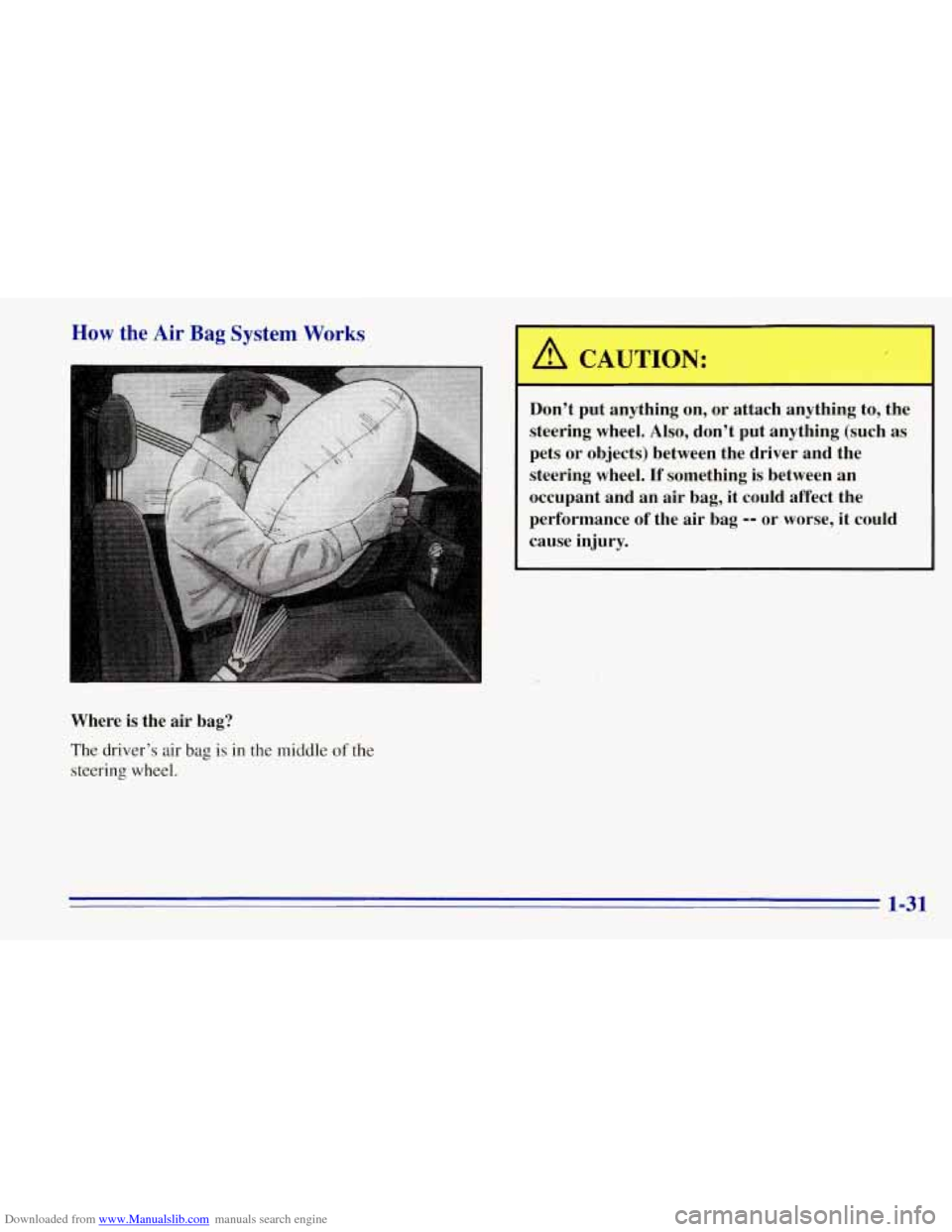
Downloaded from www.Manualslib.com manuals search engine How the Air Bag System Works
Where is the air bag?
The driver’s air bag is in the middle of the
steering wheel.
A CAUTION:
Don’t put anything on, or attach anything to, the
steering wheel. Also, don’t put anything (such as
pets or objects) between the driver and the
steering wheel.
If something is between an
occupant and an air bag, it could affect the
performance of the air bag
-- or worse, it could
cause injury.
1-31
Page 39 of 403
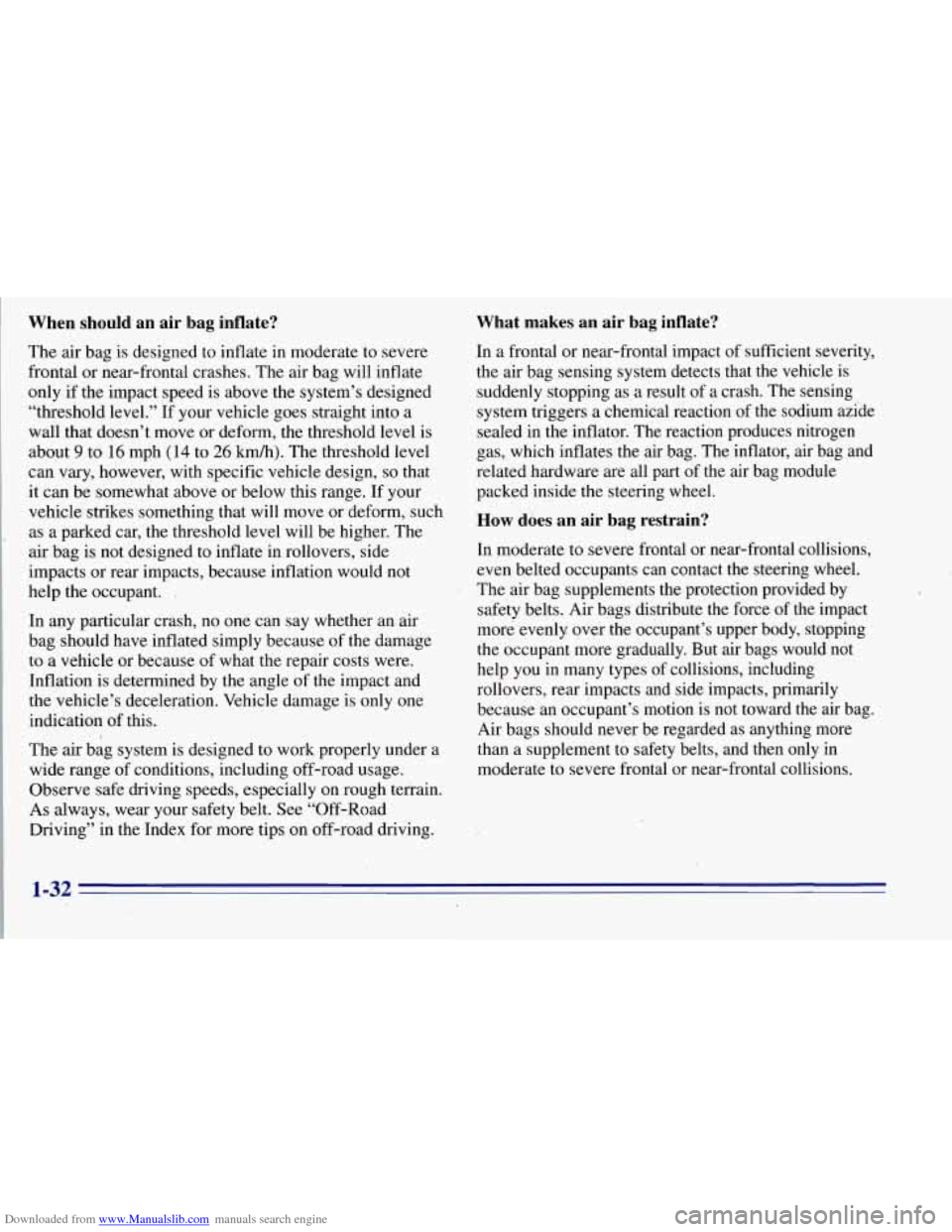
Downloaded from www.Manualslib.com manuals search engine When should an air bag inflate?
The air bag is designed to inflate in moderate to severe
frontal or near-frontal crashes. The air bag will inflate
only if the impact speed is above the system’s designed
“threshold level.” If your vehicle goes straight into a
wall that doesn’t move or deform, the threshold level is
about
9 to 16 mph (14 to 26 km/h). The threshold level
can vary, however, with specific vehicle design,
so that
it can be somewhat above or below this range. If your
vehicle strikes something that will move or deform, such
as a parked car, the threshold level will be higher. The
air bag
is not designed to inflate in rollovers, side
impacts
or rear impacts, because inflation would not
help the occupant.
.
In any particular crash, no one can say whether an air
bag should have inflated simply because of the damage
to a vehicle or because of what the repair costs were.
Inflation is determined by the angle
of the impact and
the vehicle’s deceleration. Vehicle damage is only one
indication of this.
The air bag system
is designed to work properly under a
wide range of conditions, including off-road usage.
Observe safe driving speeds, especially on rough terrain.
As always, wear your safety belt. See “Off-Road
Driving” in the Index for more tips on off-road driving.
What makes an air bag inflate?
In a frontal or near-frontal impact of sufficient severity,
the air bag sensing system detects that the vehicle is
suddenly stopping as a result of a crash. The sensing
system triggers a chemical reaction
of the sodium azide
sealed in the inflator. The reaction produces nitrogen
gas, which inflates the air bag. The inflator, air bag and
related hardware are all part of the air bag module
packed inside the steering wheel.
How does an air bag restrain?
In moderate to severe frontal or near-frontal collisions,
even belted occupants can contact the steering wheel.
The air bag supplements the protection provided by
safety belts. Air bags distribute the force of the impact
more evenly over the occupant’s upper body, stopping
the occupant more gradually. But air bags would not
help you in many types of collisions, including
rollovers, rear impacts and side impacts, primarily
because an occupant’s motion is not toward the air bag.
Air bags should never be regarded as anything more
than a supplement to safety belts, and then only in
moderate to severe frontal or near-frontal collisions.
1-32
Page 40 of 403
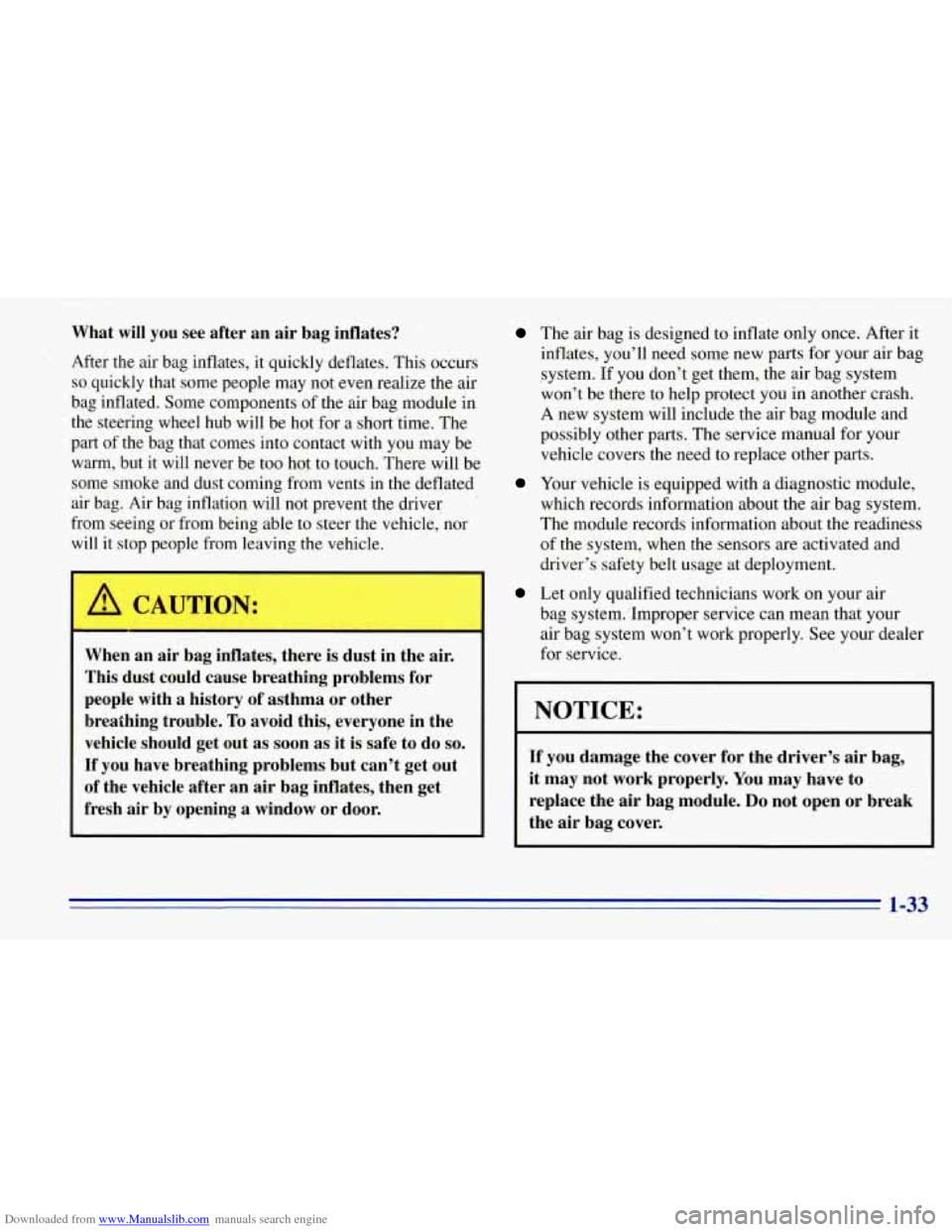
Downloaded from www.Manualslib.com manuals search engine What will you see after an air bag inflates?
After the air bag inflates, it quickly deflates. This occurs
so quickly that some people may not even realize the air
bag inflated. Some components of the air bag module in
the steering wheel hub will be hot for a short time. The
part of the bag that comes into contact with you may be
warm, but it will never be too hot to touch. There will be
some smoke and dust coming from vents in the deflated
air bag. Air bag inflation will not prevent the driver
from seeing or from being able to steer the vehicle, nor
will
it stop people from leaving the vehicle.
When an air bag inflates, there is dust in the air.
This dust could cause breathing problems for
people with a history of asthma or other
breathing trouble. To avoid this, everyone in the
vehicle should get out
as soon as it is safe to do so.
If you have breathing problems but can’t get out
of the vehicle after an
air bag inflates, then get
fresh air by opening
a window or door.
The air bag is designed to inflate only once. After it
inflates, you’ll need some new parts for your air bag
system.
If you don’t get them, the air bag system
won’t be there to help protect you in another crash.
A new system will include the air bag module and
possibly other parts. The service manual for your
vehicle covers the need to replace other parts.
Your vehicle is equipped with a diagnostic module,
which records information about the air bag system.
The module records information about the readiness
of the system, when the sensors are activated and
driver’s safety belt usage at deployment.
bag systemAmproper service can mean that your air bag system won’t work properly. See your dealer
for service.
Let only qualified technicians work on your air
I NOTICE:
If you damage the cover for the driver’s air bag,
it may not work properly. You may have to
replace the
air bag module. Do not open or break
the
air b,ag cover.
1-33
Page 71 of 403
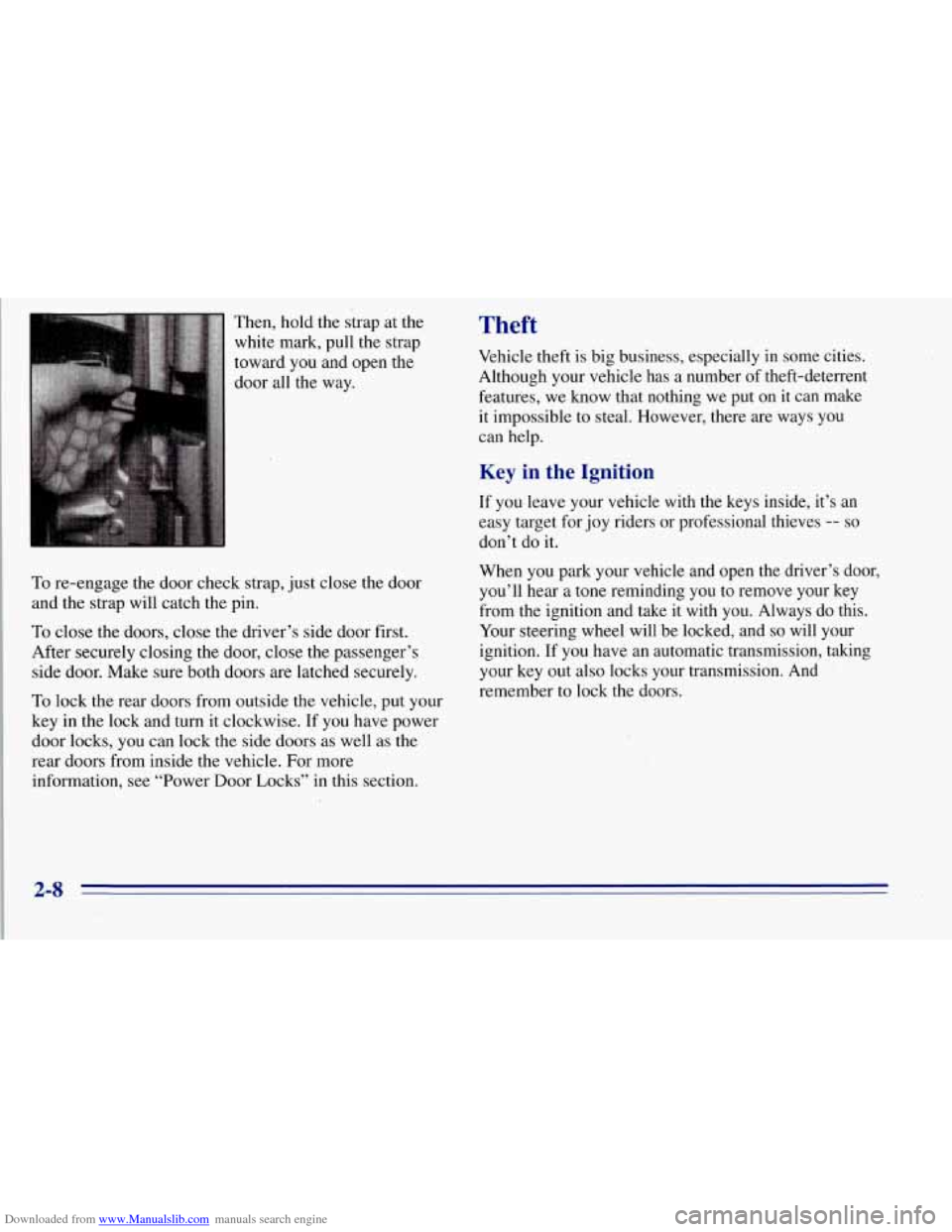
Downloaded from www.Manualslib.com manuals search engine Then, hold the strap at the
white mark, pull the strap
toward you and open the
door all the way.
To re-engage the door check strap, just close the door
and the strap will catch the pin.
To close the .doors, close the driver’s side door first.
After securely closing the door, close the passenger’s
side door. Make sure both doors
are latched securely.
To lock the rear doors from outside the vehicle, put your
key in the lock and turn it clockwise. If you have power
door locks, you can lock the side doors as well as the
rear doors from inside the vehicle. For more
information, see “Power Door Locks” in this section.
Theft
Vehicle theft is big business, especially in some cities.
Although your vehicle
has a number of theft-deterrent
features, we
know that nothing we put on it can make
it impossible
to steal. However, there are ways you
can help.
Key in the Ignition
If you leave your vehicle with the keys inside, it’s an
easy target for joy riders or professional thieves -- so
don”t do it.
When you park your vehicle and open the driver’s door,
you’ll hear a tone reminding you to remove your key
from the ignition and take it with you. Always do this.
Your steering wheel will be locked, and
so will your
ignition.
If you have an automatic transmission, taking
your key
out also locks your transmission. And
remember to lock the doors.
34
Page 73 of 403
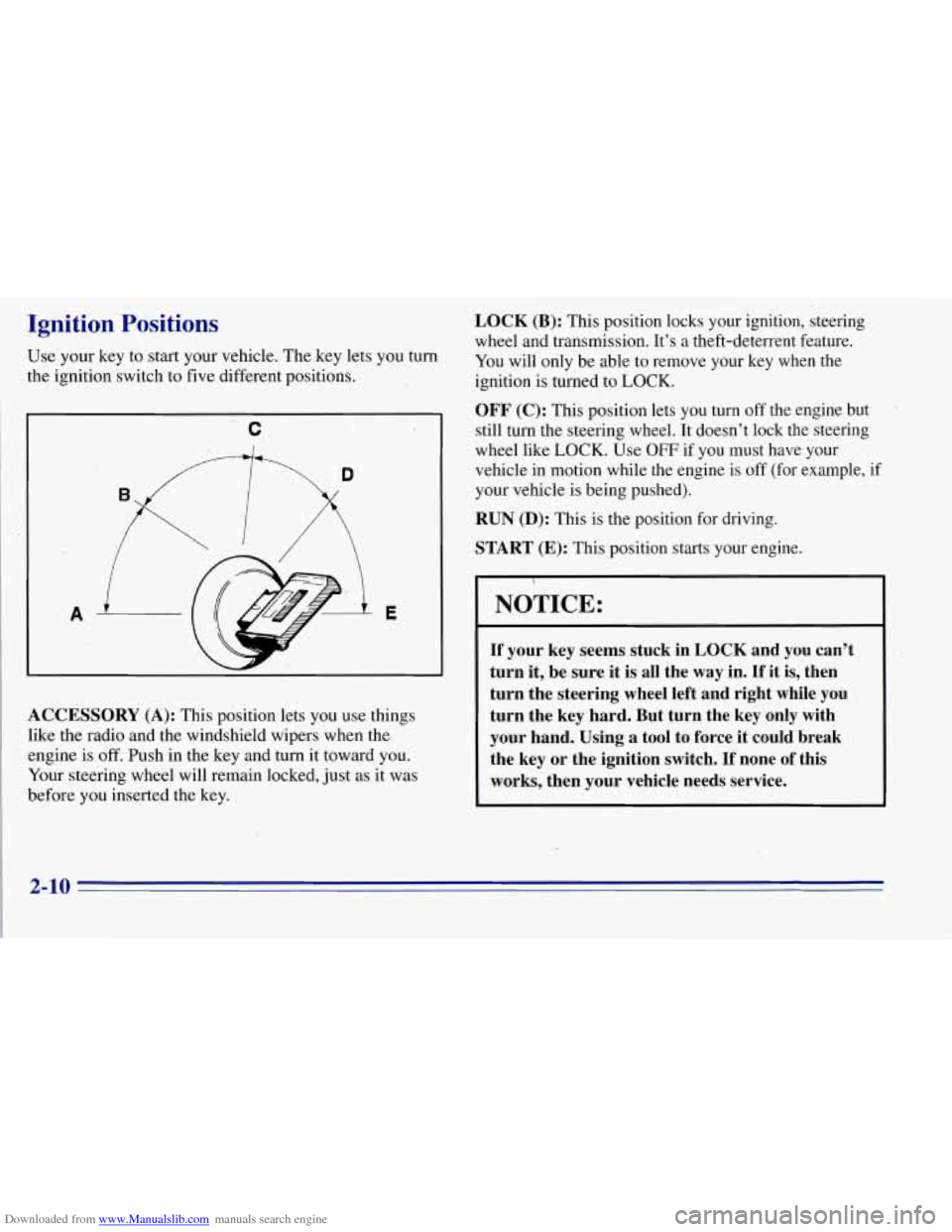
Downloaded from www.Manualslib.com manuals search engine Ignition Positions
Use your key to start your vehicle. The key lets you turn
the ignition switch to five different positions.
c
A E
--
LA
ACCESSORY (A): This position lets you use things
like the radio and the windshield wipers when the
engine is
off. Push in the key and turn it toward you.
Your steering wheel will remain locked,
just as it was
before you inserted the key.
LOCK (B): This position locks your ignition, steering
wheel and transmission. It’s a theft-deterrent feature.
You will only
be able to remove your key when the
ignition is turned to
LOCK.
OFF (C): This position lets you turn off the engine but
still turn the steering wheel. It doesn’t lock the steering
wheel like
LOCK. Use OFF if you must have your
vehicle in motion while the engine is off (for example, if
your vehicle is being pushed).
RUN (D): This is the position for driving.
.START (E): This position starts your engine.
I
NOTICE:
If your key seems stuck in LOCK and you can’t
turn it, be sure it is all the
way in. If it is, then
turn the steering wheel left and right while you
turn the key hard. But turn the key only with
your hand. Using
a tool to force it could break
the key or the ignition switch.
If none of this
works, then your vehicle needs service.
2-10
Page 85 of 403
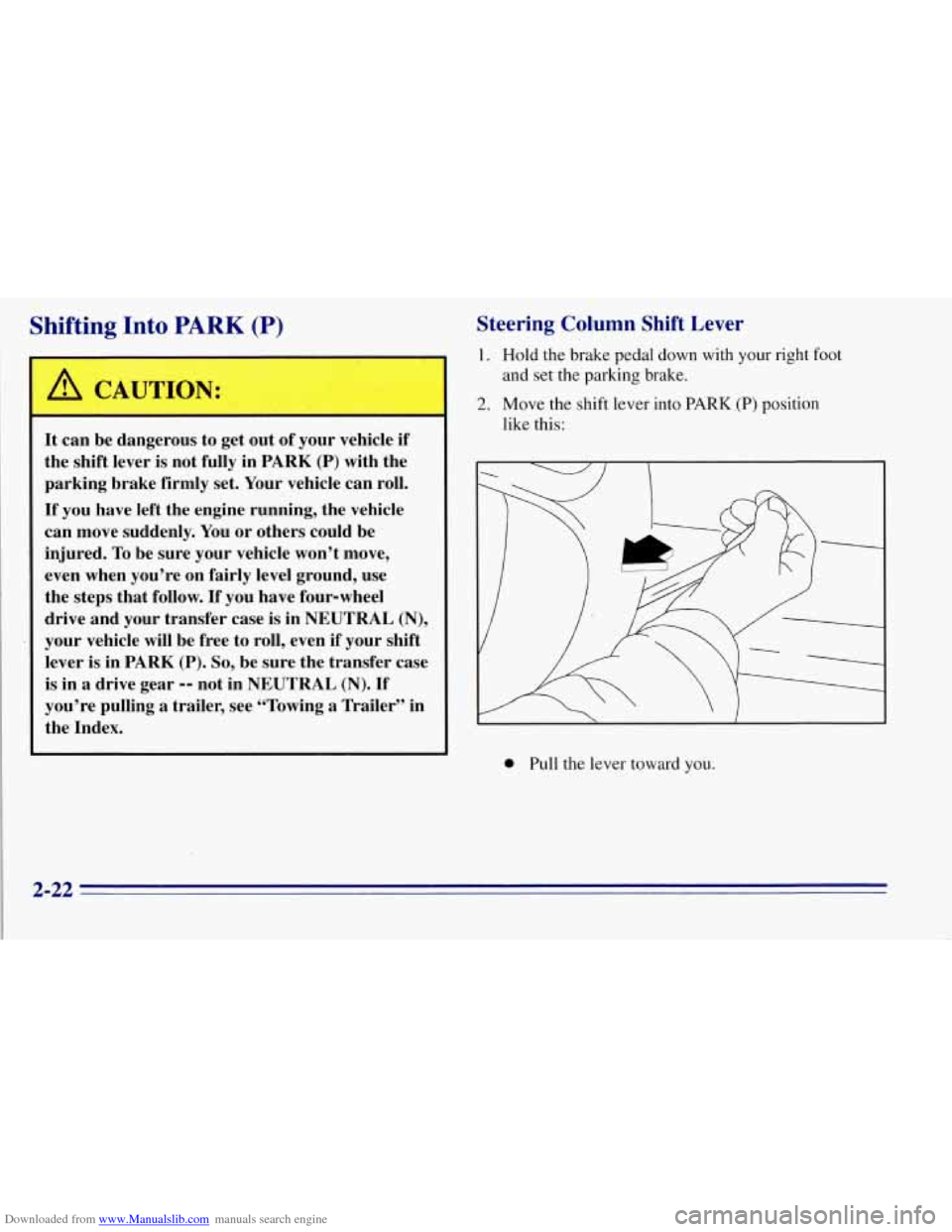
Downloaded from www.Manualslib.com manuals search engine Shifting Into PARK (P)
A CAUTION:
It can be dangerous to get out of your vehicle if
the shift lever is not fully in PARK
(P) with the
parking brake firmly set. Your vehicle can roll.
If you have left the engine running, the vehicle
can move suddenly. You or others could be
injured.
To be sure your vehicle won’t move,
even when you’re on fairly level ground, use
the steps that follow.
If you have four-wheel
drive and your transfer case is in NEUTRAL (N),
your vehicle will be free to roll, even if your shift
lever is in PARK (P).
So, be sure the transfer case
is in
a drive gear -- not in NEUTRAL (N). If
you’re pulling a trailer, see “Towing
a Trailer” in
the Index.
Steering Column Shift Lever
1. Hold the brake pedal down with your right foot
2. Move the shift lever into PARK (P) position
and set the
parking brake.
like this:
0 Pull the lever toward you.
2-22
Page 91 of 403
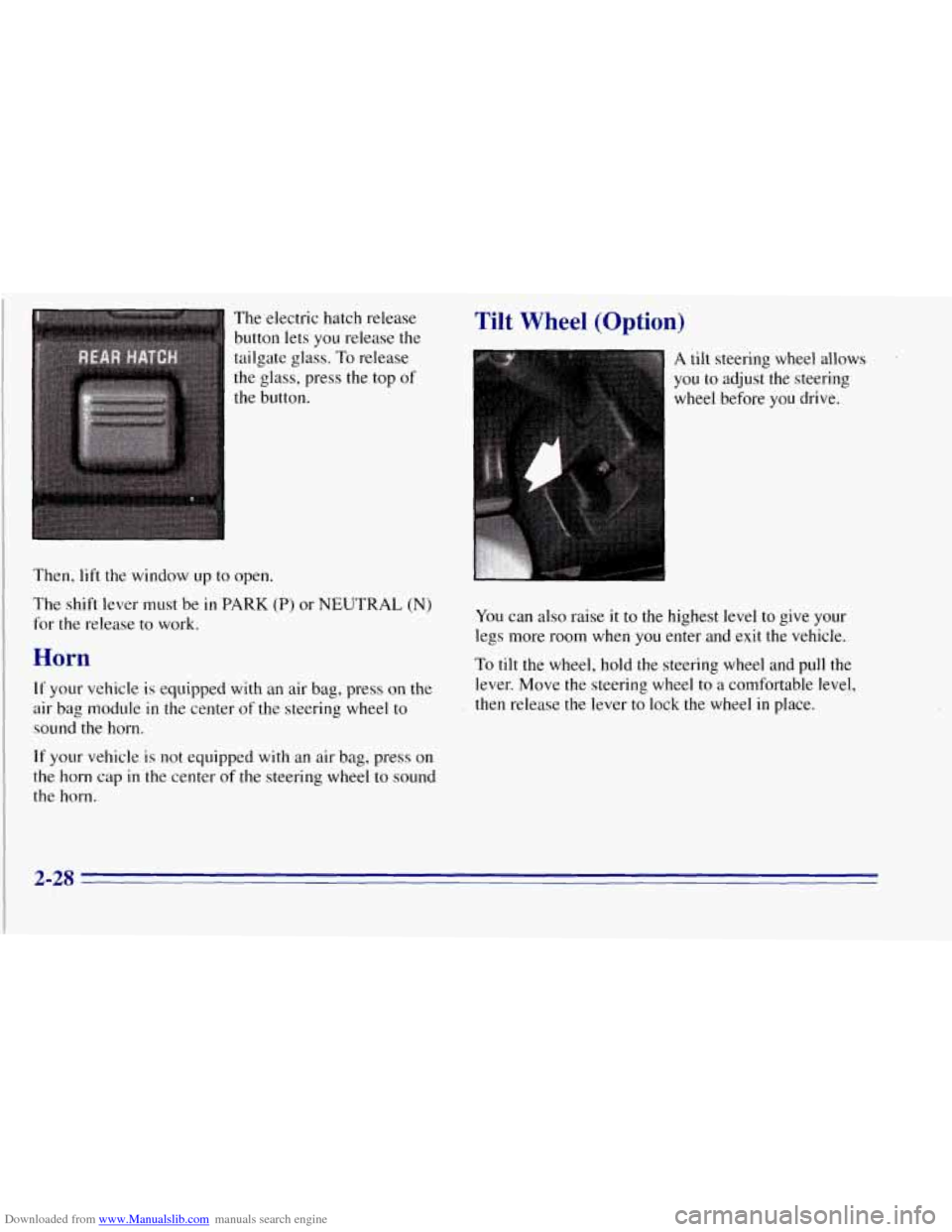
Downloaded from www.Manualslib.com manuals search engine The electric hatch release
button lets you release the
tailgate glass.
To release
the glass, press the top of
the button.
Then, lift the window up to open.
The shift lever must be in PARK (P) or NEUTRAL
(N)
for the release to work.
Horn
If your vehicle is equipped with an air bag, press on the
air bag module in the center
of the steering wheel to
sound the horn.
If your vehicle is not equipped with an air bag, press on
the horn cap in the center of the steering wheel to sound
the horn.
Tilt Wheel (Option)
A tilt steering wheel allows
you to adjust the steering
wheel before
you drive.
You can also raise it to the highest level to give your
legs more room when you enter and exit the vehicle.
To tilt the wheel, hold the steering wheel and pull the
lever. Move the steering wheel to a comfortable level,
then release the lever to lock the wheel
in place.
2-28
Page 92 of 403
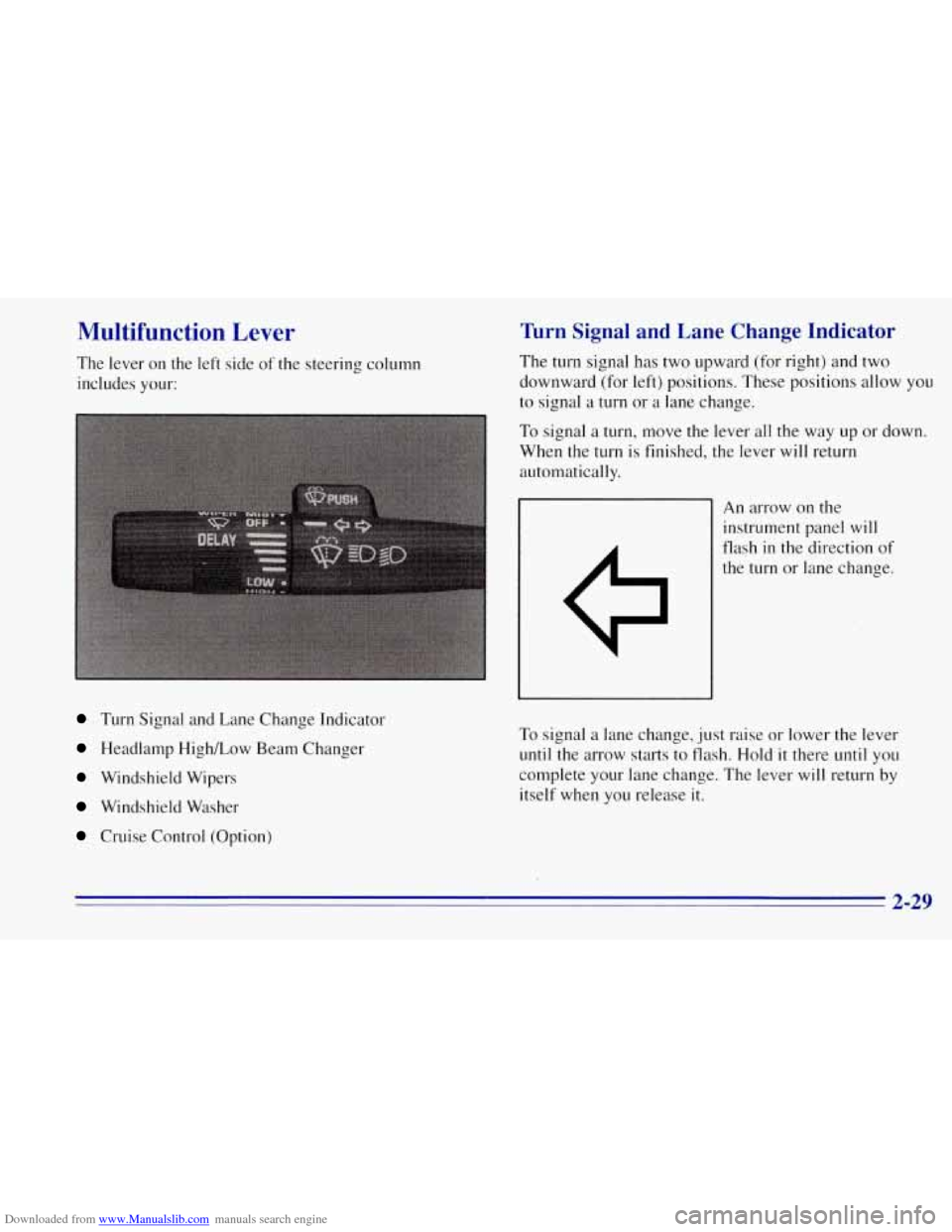
Downloaded from www.Manualslib.com manuals search engine Multifunction Lever
The lever on the left side of the steering column
includes your:
Turn Signal and Lane Change Indicator
The turn signal has two upward (for right) and two
downward (for left) positions. These positions allow you
to signal
a turn or a lane change.
To signal a turn, move the lever all the way up or down.
When the turn is finished, the lever will return
automatically.
An arrow
on the
instrument panel will
flash
in the direction of
the turn or lane change.
Turn Signal and Lane Change Indicator
Headlamp HighLow Beam Changer
Windshield Wipers
Windshield Washer
Cruise Control (Option) To
signal a lane change, just raise or lower the lever
until the arrow starts to flash. Hold it there until you
complete your lane change. The lever will return by
itself when you release it.
2-29